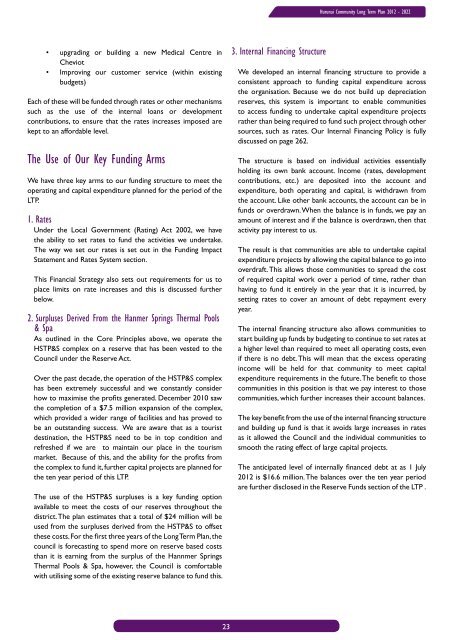LTP 2012-2022 - Introduction - Hurunui District Council
LTP 2012-2022 - Introduction - Hurunui District Council
LTP 2012-2022 - Introduction - Hurunui District Council
You also want an ePaper? Increase the reach of your titles
YUMPU automatically turns print PDFs into web optimized ePapers that Google loves.
<strong>Hurunui</strong> Community Long Term Plan <strong>2012</strong> - <strong>2022</strong><br />
• upgrading or building a new Medical Centre in<br />
Cheviot<br />
• Improving our customer service (within existing<br />
budgets)<br />
Each of these will be funded through rates or other mechanisms<br />
such as the use of the internal loans or development<br />
contributions, to ensure that the rates increases imposed are<br />
kept to an affordable level.<br />
The Use of Our Key Funding Arms<br />
We have three key arms to our funding structure to meet the<br />
operating and capital expenditure planned for the period of the<br />
<strong>LTP</strong>.<br />
1. Rates<br />
Under the Local Government (Rating) Act 2002, we have<br />
the ability to set rates to fund the activities we undertake.<br />
The way we set our rates is set out in the Funding Impact<br />
Statement and Rates System section.<br />
This Financial Strategy also sets out requirements for us to<br />
place limits on rate increases and this is discussed further<br />
below.<br />
2. Surpluses Derived From the Hanmer Springs Thermal Pools<br />
& Spa<br />
As outlined in the Core Principles above, we operate the<br />
HSTP&S complex on a reserve that has been vested to the<br />
<strong>Council</strong> under the Reserve Act.<br />
Over the past decade, the operation of the HSTP&S complex<br />
has been extremely successful and we constantly consider<br />
how to maximise the profits generated. December 2010 saw<br />
the completion of a $7.5 million expansion of the complex,<br />
which provided a wider range of facilities and has proved to<br />
be an outstanding success. We are aware that as a tourist<br />
destination, the HSTP&S need to be in top condition and<br />
refreshed if we are to maintain our place in the tourism<br />
market. Because of this, and the ability for the profits from<br />
the complex to fund it, further capital projects are planned for<br />
the ten year period of this <strong>LTP</strong>.<br />
The use of the HSTP&S surpluses is a key funding option<br />
available to meet the costs of our reserves throughout the<br />
district. The plan estimates that a total of $24 million will be<br />
used from the surpluses derived from the HSTP&S to offset<br />
these costs. For the first three years of the Long Term Plan, the<br />
council is forecasting to spend more on reserve based costs<br />
than it is earning from the surplus of the Hannmer Springs<br />
Thermal Pools & Spa, however, the <strong>Council</strong> is comfortable<br />
with utilising some of the existing reserve balance to fund this.<br />
3. Internal Financing Structure<br />
We developed an internal financing structure to provide a<br />
consistent approach to funding capital expenditure across<br />
the organisation. Because we do not build up depreciation<br />
reserves, this system is important to enable communities<br />
to access funding to undertake capital expenditure projects<br />
rather than being required to fund such project through other<br />
sources, such as rates. Our Internal Financing Policy is fully<br />
discussed on page 262.<br />
The structure is based on individual activities essentially<br />
holding its own bank account. Income (rates, development<br />
contributions, etc.) are deposited into the account and<br />
expenditure, both operating and capital, is withdrawn from<br />
the account. Like other bank accounts, the account can be in<br />
funds or overdrawn. When the balance is in funds, we pay an<br />
amount of interest and if the balance is overdrawn, then that<br />
activity pay interest to us.<br />
The result is that communities are able to undertake capital<br />
expenditure projects by allowing the capital balance to go into<br />
overdraft. This allows those communities to spread the cost<br />
of required capital work over a period of time, rather than<br />
having to fund it entirely in the year that it is incurred, by<br />
setting rates to cover an amount of debt repayment every<br />
year.<br />
The internal financing structure also allows communities to<br />
start building up funds by budgeting to continue to set rates at<br />
a higher level than required to meet all operating costs, even<br />
if there is no debt. This will mean that the excess operating<br />
income will be held for that community to meet capital<br />
expenditure requirements in the future. The benefit to those<br />
communities in this position is that we pay interest to those<br />
communities, which further increases their account balances.<br />
The key benefit from the use of the internal financing structure<br />
and building up fund is that it avoids large increases in rates<br />
as it allowed the <strong>Council</strong> and the individual communities to<br />
smooth the rating effect of large capital projects.<br />
The anticipated level of internally financed debt at as 1 July<br />
<strong>2012</strong> is $16.6 million. The balances over the ten year period<br />
are further disclosed in the Reserve Funds section of the <strong>LTP</strong> .<br />
23

















